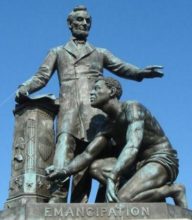Just over a week after his capture, John Brown stood trial. He was charged with treason, conspiracy and murder. It must have been quite a sight: the courtroom was packed with witnesses, journalists and spectators, while John Brown was lying on a cot due to stab wounds he had sustained during his arrest. Brown’s lawyer made an insanity plea, but Brown wasn’t having it: “I am perfectly unconscious of insanity, and I reject, so far as I am capable, any attempt to interfere in my behalf on that score.” He knew the trial was his only chance to get his case against slavery on the front page of the nation’s newspapers, and being described as crazy would not help his argument.

Grave of John Brown
The trail took four days. The jury – all slave owners – found Brown guilty on all charges. He would be hanged a month later. Four of his surviving raiders received similar sentences. To add to the drama, Brown sat on his own coffin in the back of a horse-drawn wagon on his way to the gallows.
Frenzy
During the raid, fear of a massive slave rebellion sent the people of Harpers Ferry into a frenzy, further fueled by the liquor that was served in the saloons throughout the night. Dangerfield Newby, an ex-slave who had joined John Brown hoping it would lead to the release of his enslaved wife and children, was shot and killed, his body heavily mutilated and left for hogs to eat (the alley where this took place is still called Hog Alley). William Leeman, who had killed the mayor of Harpers Ferry, was shot while attempting to escape across the river. Angry townspeople and militia men used his body for shooting practice for hours afterwards. They also turned on raider William Thompson who was taken prisoner at some point during the raid. He was dragged onto the bridge, shot and thrown into the river, where the mob emptied their rifles into him. John Copeland surrendered and was greeted by an angry crowd shouting “Lynch him! Lynch him!” One of the slaves John Brown freed during the raid was beaten unconscious and drowned.

Dangerfield Newby
War fever
A journalist at that time wrote: “The Harpers Ferry invasion has advanced the cause of Disunion more than any other event that has happened since the formation of Government.” The war fever that had already began to emerge grew fast. The excessive response of both the military and the townspeople was a clear symptom. Although John Brown’s army was only small, multiple militias from nearby Frederick, Charles Town, Martinsburg, Shepherdstown and Winchester marched to Harpers Ferry to suppress the revolt. Robert E. Lee brought no less than ninety U.S. Marines with him. Not what you would call a fair fight.
Domino effect

Emancipation Memorial
The raid made clear that compromise was no longer an option. While the voices against slavery in the North grew louder, the South felt more and more threatened. Both sides braced themselves for a conflict. John Brown’s actions created a domino effect. The aftermath split the pro-slavery Democratic Party in two, while the Republican Abraham Lincoln went from dark horse to frontrunner for the presidential candidacy of 1860. Soon after his election, South Carolina was the first state to secede. Civil war was coming, as John Brown seems to have predicted in a note he wrote shortly before his execution: “I, John Brown, am now quite certain that the crimes of this guilty land will never be purged away but with Blood.”
In hindsight, the raid on Harpers Ferry seems merely a prelude. When the war ended, four million enslaved people were freed. So, if we could ask him, would Brown consider his failed raid a success in that sense? With 620,000 soldiers and 50,000 civilians dead, it would be an extremely hard question to answer.